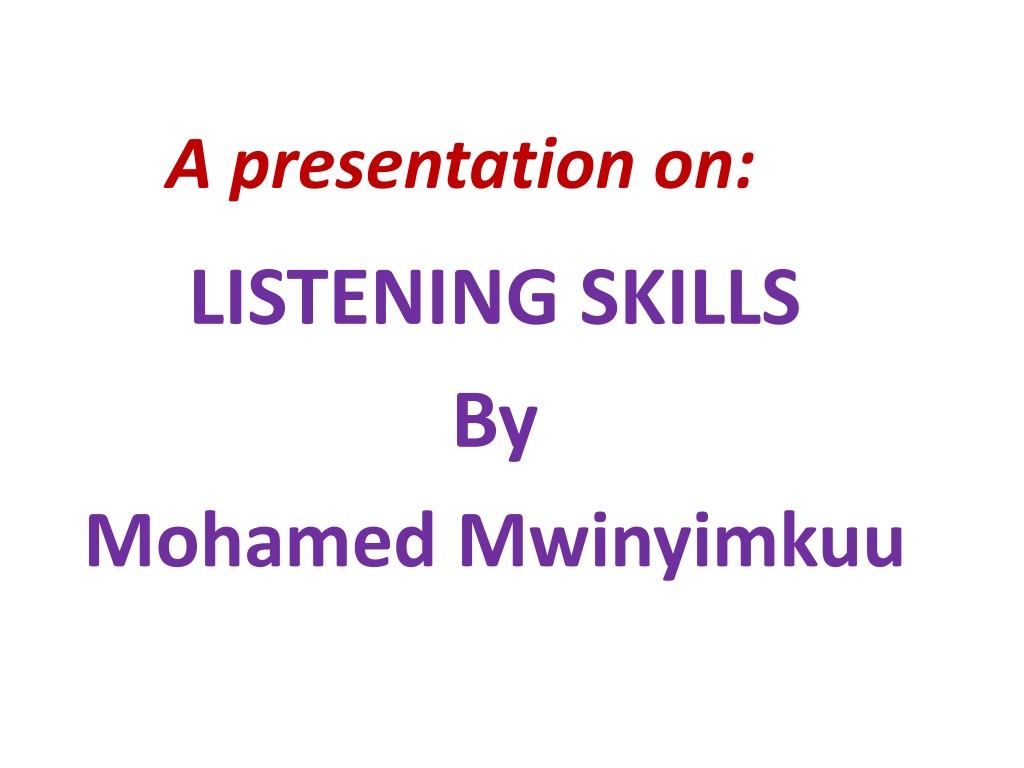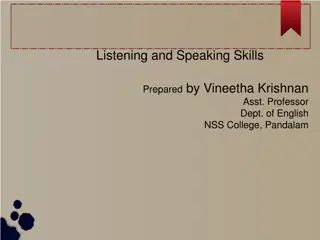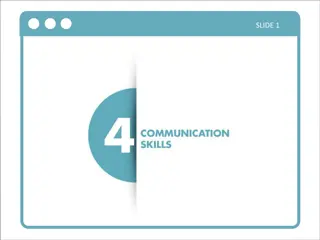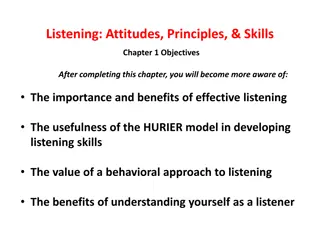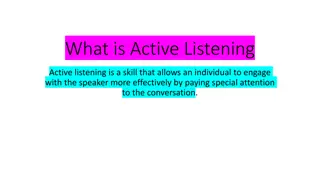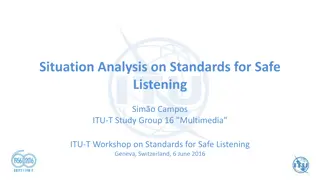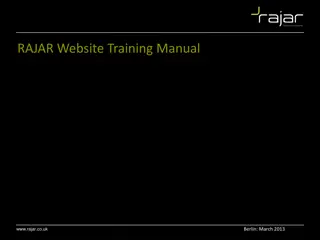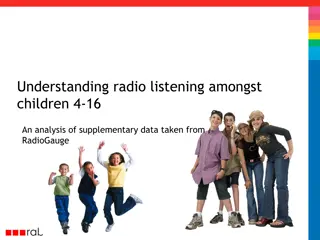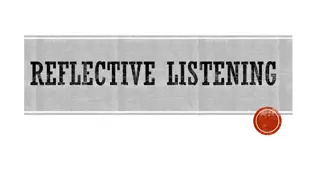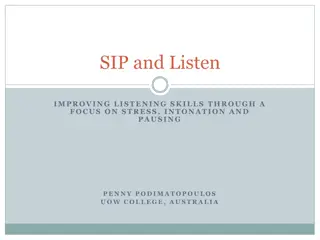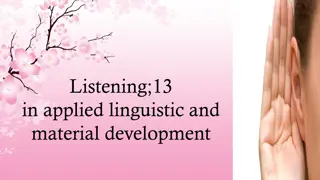Mastering Listening Skills
Enhance your communication through effective listening skills. Learn the importance, types, and process of listening. Understand the difference between hearing and listening, and how to actively engage in the listening process for improved understanding.
Uploaded on Feb 21, 2025 | 0 Views
Download Presentation

Please find below an Image/Link to download the presentation.
The content on the website is provided AS IS for your information and personal use only. It may not be sold, licensed, or shared on other websites without obtaining consent from the author. Download presentation by click this link. If you encounter any issues during the download, it is possible that the publisher has removed the file from their server.
E N D
Presentation Transcript
A presentation on: LISTENING SKILLS By Mohamed Mwinyimkuu
Introduction: Listening comes first Difference between Hearing & Listening Definition of Listening & Listening Skills Importance of Listening Skills Types of Listening Skills Effective Listening Features of Listening Process of Listening Techniques of Listening Skills
Listening Comes First The first and foremost communication skill that we learn in our lives is nothing but Listening Listening Speaking Reading Writing
Difference Between Hearing & Listening Hearing: Hearing is simply the act of perceiving sound by the ear. Hearing occurs with or without your consent. Listening: Listening is an action where you choose to actively to concentrate on what you hear. In listening your brain processes information into knowledge.
What is listening? Listening is the ability to accurately receive and interpret messages in the communication process. Listening is a key to all effective communication, without the ability to listen effectively messages are easily misunderstood. Listening is the process of receiving, constructing meaning from, and responding to spoken.
What is listening? Listening is not just about being Quiet while someone else is speaking. Listening is with the Mind. Hearing with the senses. Listening is conscious. To improve our interpersonal & oral exchange. Just Listening to words is not enough; a good Listener has to pay attention to the non-verbal communication of the speaker.
Process Of Listening 1. Receiving Is the intentional focus on hearing a speaker s message. This stage is represented by the ear because it is the primary tool involved with this stage of the listening process.
Process Of Listening 2. Understanding In the understanding stage, we attempt to learn the meaning of the message, which is not always easy. Deciding what the message means to you.
Process Of Listening 3. Remembering Remembering begins with listening; if you can t remember something that was said, you might not have been listening effectively. However, even when you are listening attentively, some messages are more difficult than others to understand and remember. Highly complex messages that are filled with detail call for highly developed listening skills.
Process Of Listening 4. Evaluating The fourth stage in the listening process is evaluating. evaluations of the same message can vary widely from one listener to another. The stages two, three, and four are represented by the brain because it is the primary tool involved with these stages of the listening process.
Process Of Listening 5. Responding Responding sometimes referred to as feedback is the fifth and final stage of the listening process. Your reaction to the message. It can be emotional and intellectual For example, you are giving positive feedback to your instructor if at the end of class you stay behind to finish a sentence in your notes or approach the instructor to ask for clarification. The opposite kind of feedback is given by students who gather their belongings and rush out the door as soon as class is over. This stage is represented by the lips because we often give feedback in the form of verbal feedback; however, you can just as easily respond nonverbally.
What are listening skills? Listening Skills are the ways to help you listen something more effectively.
Importance of Listening Skills An attentive listener stimulates better speaking by the speaker. A good listener learns more than an ordinary listener. A good listener learns to detect prejudices, assumptions and attitudes. Communication is not complete without effective listening.
Types of Listening Discriminative Listening Pretense Listening Selective Listening Attentive/Active Listening
Types of Listening Discriminative Listening: It involves identifying the difference between various sounds. It also enables one to differentiate between familiar and unfamiliar language. Active Listening: Is a communication technique used in counseling, training, and conflict resolution. It requires that the listener fully concentrate, understand, respond and then remember what is being said.
Types of Listening Pretense Listening: It involves more hearing than listening. It means pretending through facial expressions that one is listening when actually one is not. Selective Listening: It involves selecting the desired part of the message and ignoring the undesired part of the message.
Active Listening In effective Listening, it is important to learn, to summarize and reflect smoothly, without appearing to mimic or repeat back in a robotic fashion. Useful phrases are: As I understand it, what you are saying is . So your point is that .
Effective Listening Effective/Active Listening Is Actively Absorbing The Information Given To You By The Speaker Showing That You Are Interested. It Can Also Include Providing The Speaker With The Feedback, By Asking Relevant Questions So The speaker Knows The Message Is Received.
Benefits of Effective Listening If we were supposed to talk more than listen, we would have been two mouths and one ear, Mark Twain.
Benefits of Effective Listening Listening builds stronger relationships: It creates a desire to cooperate among people because they feel accepted and acknowledged. Listening leads learning, opennes encourages, personal growth and learning. Enhances decision making Improves understanding
Barriers & Benefits of Effective Listening
Can you hear me talking? Does that mean that you are a good listener? A person with normal hearing is not necessarily a good listener. Many different things can prevent a speaker s message from being received These are called barriers to listening.
Barriers Of Effective Listening 1. Physiological barriers Physiological barriers of listening are related with the limitations of the human body and the human mind (memory, attention, and perception). Physiological barriers may result from individuals personal discomfort, caused by ill-health, poor eye sight, or hearing difficulties.
Physiological barriers Poor retention due to memory problem Lack of attention Discomfort due to illness Poor sensory perception Hearing problems Poor listening skills Information overload Gender physiological differences.
Barriers Of Effective Listening 2. Environmental barriers/physical barriers These are obstacles which affect listening and in most situation they are easy to correct: Problem with the hearing aids. Use of microphones which do not project as it supposed to be heard. Noise. If it is difficult to see the speaker or if there is something more interesting to look at. The chair uncomfortable. The room is too hot or too cold. Smells.
Environmental barriers/physical barriers Loud background noise. Poor lighting. Uncomfortable setting. Very hot or cold room. Distance.
Barriers Of Effective Listening 3. Psychological barriers. Wondering mind or inattention (fact; the brain can process over 500 words per minute while the average speaker talks at a rate of 125 to 250 words per minute) Bias and prejudice i.e negative attitudes towards the speaker or the topic. Anger , frustration. Own anxiety/nervous i.e worried about. Status difference.
Psychological barriers. Distrust & unhappy emotions Emotional disturbance. Worry, fear anxiety & confused thinking.
Barriers Of Effective Listening 4. Social barriers Social barriers to communication include the social phenomenon of conformity, a process in which the norms, values, and behaviors of an individual begin to follow those of the wider group. Social factors such as age, gender, socioeconomic status, and marital status may act as barrier to communication in certain situations.
Social barriers Social taboos Difference in social norms, values, & behavior. Different social strata.
Barriers Of Effective Listening 5. Linguistic barriers. Individual linguistic ability may sometimes become a barrier to listening. The use of difficult or inappropriate words in communication can prevent the people from understanding the message. Poorly explained or misunderstood messages can also result in confusion. The linguistic differences between the people can also lead to communication breakdown. The same word may mean differently to different individuals.
Linguistic barriers. Faulty language translation. Jargon or specialist language. Inappropriate tone. Hesistant manner. Bad organized material. Complex vocabulary.
Barriers Of Effective listening 6. Cultural barriers. Culture shapes the way we think and behave. It can be seen as both shaping and being shaped by our established patterns of communication. Cultural barrier to communication often arises when individuals in one social group have developed different norms, values, or behaviors to individuals associated with another group. Cultural difference leads to difference in interest, knowledge, value, and tradition. Therefore people of different cultures will experience these culture factors as a barrier to communicate with each other.
Cultural barriers. Ethnic, religious & cultural differences. Cultural tradition, values & behavior.
How To Listen Effectively? 1. Stop Talking Be Silent 2. Show Interest 3. Empathize 4. Ask Questions 5. Maintain Eye Contact 6. Take notes 7. Listen Creatively 8. Put Your Entirety 9. Send feedback 10. Avoid or eliminate distraction 11. Try to gather information about the topic to develop interest and familiarity
